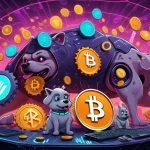Astra Nova’s TokenPlay AI: $RVV Launch to Transform IPs into Blockchain Revenue Machines

The AI MiniApp Gold Rush: Astra Nova’s TokenPlay AI Aims to Turn IPs Into Revenue Machines
Astra Nova is gearing up to launch its $RVV token on October 18th through the TokenPlay AI platform, a bold new player in the crypto infrastructure game. This isn’t just another speculative altcoin drop; it’s a calculated move to empower creators and intellectual properties (IPs) with blockchain-based MiniApps, backed by a revenue model that prioritizes platform fees over empty hype. With heavyweight partnerships and a deflationary twist, this could be a game-changer—or a cautionary tale.
- Launch Details: $RVV token rollout set for October 18th on TokenPlay AI.
- Revenue Focus: Platform fees drive buybacks and burns for $RVV scarcity.
- Massive Reach: Tied to Shiba Inu, Simon’s Cat, and 169 million telecom users.
TokenPlay AI: Redefining Crypto Infrastructure
Let’s get straight to the point: TokenPlay AI isn’t here to peddle the usual meme coin nonsense that has degens throwing cash at rug pulls. This platform, developed by Astra Nova, is an infrastructure play designed to let creators and established IPs build MiniApps—think lightweight, blockchain-powered applications like games or loyalty programs that run with decentralized incentives. Imagine smartphone apps, but with token-based rewards and no corporate middleman skimming the top. The goal is to monetize creativity directly, cutting out traditional gatekeepers with a system that generates real revenue through transaction and usage fees. For a deeper look into this innovative approach, check out Astra Nova’s TokenPlay AI initiative.
What sets this apart in the crowded crypto space is its economic model. Unlike most token launches banking on speculative pumps, TokenPlay AI uses its platform fees for automatic buybacks of $RVV tokens, which are then burned—permanently removed from circulation. This creates a deflationary pressure: as transaction volume grows, supply shrinks, potentially boosting value for holders without relying on market mania. It’s a refreshing pivot from the altcoin casinos promising the moon and delivering dust. But the question looms—can they pull it off, or is this just another shiny promise in a sea of scams?
The Power of Partnerships and Pre-Launch Hype
Astra Nova isn’t starting from scratch, and that’s a big deal. They’ve lined up a waitlist of 250,000 creators ready to jump on board and build MiniApps once the platform goes live. That’s a potential user base most startups would kill for before even flipping the switch. Then there’s the partnerships: Shiba Inu, a crypto juggernaut with millions of holders globally, and Simon’s Cat, an IP with 1.8 million Instagram followers and its own token, are collaborating to craft whitelabel MiniApp experiences. These aren’t just logos slapped on a whitepaper—they bring built-in communities and credibility.
On top of that, a tie-up with The Binary Holdings grants access to a staggering 169 million telecom users across Southeast Asia. That’s a distribution network that could turbocharge adoption if leveraged right. Already, Astra Nova’s ecosystem—including a Loyalty Questing Platform and a Telegram game—boasts 200,000 daily active users. This isn’t a project begging for attention; it’s walking in with a crowd already cheering. If these alliances translate into active engagement, TokenPlay AI might just rewrite the playbook for how crypto projects launch with momentum.
Revenue Over Hype: Learning from the Giants
The crypto world is shifting toward infrastructure that generates cold, hard cash through activity rather than speculation, and TokenPlay AI is riding that wave. Look at Pump.fun, a token launch platform that’s become a cash cow by enabling creators. According to DefiLlama data, it raked in $15.5 million in fees in a single day back in January, $35.7 million over the past 30 days, and over $803 million since its debut. Another player, LetsBonk.fun, hit $1 million in daily fees in July while launching 16,000 tokens in just 24 hours with 37,000 active users. The lesson? Platforms that empower creation can outpace even heavyweights like Ethereum in fee generation on peak days.
TokenPlay AI aims to follow this path, but with its own spin. By tying platform revenue directly to $RVV buybacks and burns, it’s betting on sustainable value over short-term pumps. If it captures even a sliver of the success seen by competitors, it could be a serious contender in the blockchain MiniApp space. This focus on fees as a metric of success is a breath of fresh air in a sector too often obsessed with price charts and moon memes. It’s about building something people use, not just trade.
Tech Backbone and Financial Muscle
Under the hood, Astra Nova isn’t cutting corners. TokenPlay AI runs on Alibaba Cloud, a powerhouse with global reach, ensuring the platform can handle a flood of users when launch day hits. It also integrates NVIDIA AI tools, which hints at advanced capabilities for creators—think smarter MiniApps with personalized features like tailored loyalty rewards or automated content. Could this be the edge that makes building on TokenPlay AI irresistible? If so, the tech stack alone could draw in developers looking for cutting-edge tools.
Financially, they’re not scraping by either. With $4.7 million raised to fuel development and marketing, Astra Nova has the war chest to push hard. For traders, $RVV’s debut on Tier 1 exchanges, alongside a reported Binance campaign coinciding with the October 18th rollout, signals serious visibility. That kind of access isn’t handed out to just any project—it’s a sign of confidence from major players. But tech and funding mean nothing if the user base doesn’t show up or if the system buckles under pressure. History has no shortage of well-funded flops.
Risks on the Horizon: Popping the Hood
Before we get carried away with the hype, let’s check for rust under this shiny exterior. The buyback-and-burn mechanism sounds slick, but it’s only as good as the platform’s adoption. If those 250,000 creators on the waitlist don’t turn into active builders, or if transaction volume stays flat, those buybacks won’t dent the supply enough to matter. Competing platforms like Pump.fun already have a head start and loyal user bases—can TokenPlay AI steal market share, or will it be drowned out in the noise?
Scalability is another concern. Even with Alibaba Cloud’s infrastructure, crypto history is littered with platforms that crashed under unexpected demand. Remember the Ethereum gas fee spikes during NFT minting frenzies? A similar bottleneck could sour first impressions here. Then there’s the regulatory minefield. Partnering with telecom giants to reach 169 million users sounds fantastic until you consider the patchwork of laws across Southeast Asia. Singapore demands strict licensing, while countries like Thailand have flip-flopped on bans. Navigating this could be a nightmare, stalling growth or worse.
Lastly, let’s not forget the broader crypto landscape. The space is brutal—projects with great ideas often die from poor execution or get overshadowed by the next shiny thing. If adoption flops, this deflationary dream could turn into a ghost town. Astra Nova needs to deliver on utility, not just promises, or it risks becoming another footnote in the long list of “what could have been” altcoin experiments.
Why This Matters for Crypto’s Future
Despite the risks, there’s plenty to be optimistic about. TokenPlay AI represents a shift toward revenue-generating infrastructure that aligns with the ethos of decentralization. It’s a middle finger to centralized gatekeepers, letting creators and IPs cash in directly through blockchain MiniApps. This could fast-track a decentralized future where everyday tools—games, rewards, social apps—are powered by crypto, embodying the spirit of effective accelerationism. We’re not just talking disruption; we’re talking about shoving blockchain into the mainstream at warp speed.
For Bitcoin maximalists, platforms like this might raise an eyebrow. Sure, $RVV and altcoin experiments aren’t the endgame—Bitcoin remains the king of censorship-resistant, decentralized money. But these niche plays fill gaps Bitcoin doesn’t touch, testing tokenomics and user acquisition in ways that could inform broader adoption. If Astra Nova delivers on half its vision, it might offer a blueprint for sustainable economics in a space too often derided for scams and hype. If it fails, it’ll be a stark reminder that even the best-laid plans can crumble without ruthless execution.
Key Takeaways and Questions
- What makes TokenPlay AI stand out among crypto platforms?
Its revenue-driven model uses platform fees for $RVV buybacks and burns, paired with pre-launch partnerships like Shiba Inu and access to 169 million telecom users, setting it apart from speculative token launches. - How does the $RVV buyback-and-burn system work for holders?
Platform fees are used to buy back $RVV tokens and remove them from circulation, reducing supply as usage grows, which could drive value if transaction volume scales as hoped. - Why are platform fees becoming a key metric in blockchain projects?
Fees signal real economic activity, as seen with Pump.fun’s $803 million haul, offering a more sustainable measure of success than volatile price spikes often tied to hype. - What hurdles could Astra Nova face after the October 18th debut?
Challenges include low adoption despite the creator waitlist, scalability issues under high demand, and regulatory complexities with telecom partnerships across Southeast Asia. - How critical are pre-launch partnerships for crypto success?
Extremely—ties with Shiba Inu and Simon’s Cat bring instant audiences and trust, solving the common problem of building a user base from zero in a competitive market.
As the $RVV token introduction looms on October 18th, the crypto world has a lot to digest. Astra Nova is placing a big bet on a model that values revenue over rhetoric, utility over insanity. Whether it ignites a MiniApp revolution or stumbles under its own ambition, one thing is certain: the race for AI-driven, creator-centric blockchain platforms is on fire, and TokenPlay AI is gunning for a spot at the top. We’ll be watching every move—success or failure, there’s a lesson here for the future of decentralized innovation.


